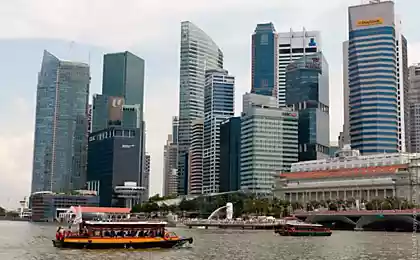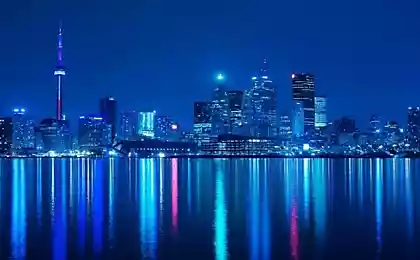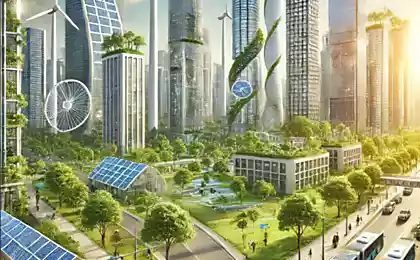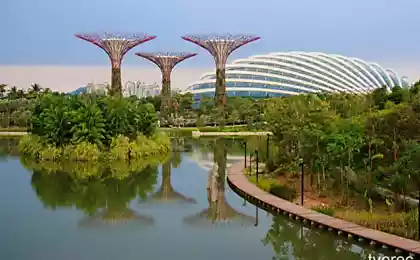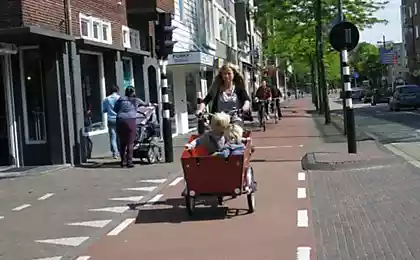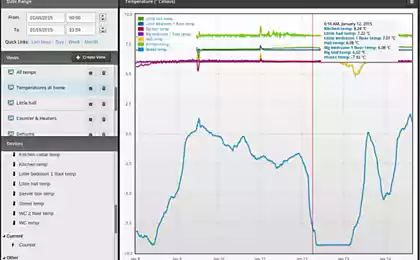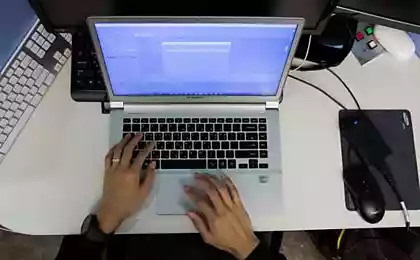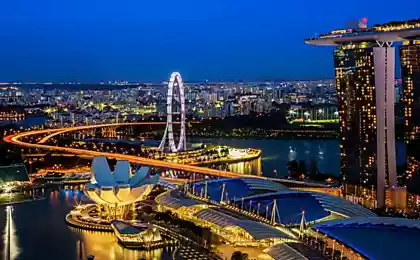1096
The economic miracle of Singapore style
Singapore - a small but amazing country. Year of independence, 1965, the second, was the beginning of the path of the state of the poor countries of the third world to one of the recognized world leaders, both in terms of economic development and the standard of living and introduced technologies. This year, Singapore topped the rating of smart cities according to Juniper Research. About distinctive way of this amazing city-ministates, its achievements and immediate prospects will be discussed in our current publications.
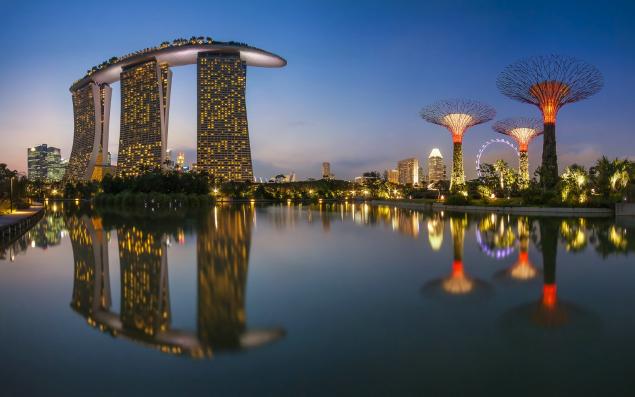
Smart Nation project, supported by the Government of Singapore, managed to unite entrepreneurs, scientists, officials and citizens in the framework of common objectives for the implementation of new technologies in everyday life and the creation of a pragmatic and comfortable environment. The ambitious plans of Singapore - claim to being the most technologically advanced country in the world. "To survive, the Singapore government has to be extraordinary. If we are ordinary, we simply will not "- so once defined his view of the future of this wonderful country one of the national leaders of the XX century and the authors of" Singapore economic miracle "Lee Kuan Yew
After separation from Malaysia in the mid 60-ies of the XX century, Singapore was in a very dependent and straitened circumstances - without an army and support between the permanent conflict Indonesia and Malaysia, one-on-one with social and economic problems, with extremely limited access to natural resources and, of course, traditional Asian level corruption. From the standpoint of the history of mankind timeslot looks negligible, but these few decades have become a real challenge for the country in 50 years, she was able to pass with dignity.

The planned development of the market economy, international investment flows, relentless fight against corruption and skilful diplomacy in the international arena brought to Singapore for the first position on the level of well-being on a global scale. The rapid economic growth in the period from the 60s to the 90s of XX century identified for Singapore, as well as to Hong Kong, Taiwan and South Korea in the famous "four Asian tigers." The decisive role played in this achievement rate for the electronics development and implementation of cutting-edge technologies. This, in turn, allowed the beginning of the third millennium, to create the country's excellent conditions for further rapid development of information technology.
Some statistics
For success in the implementation of the program of mass introduction of high-speed Internet, which is a city-state launched in 1998, the year in 1999. The Intelligent Community Forum (ICF) has recognized Singapore best "Intelligent Community of the Year". The spread of the Internet at this stage are actively supported by the government, which allowed already by 2003 to connect to the network 65% of homes and workplaces. At the same time 74% of the population of Singapore owned PC.
At the beginning of the 3rd millennium Singapore focused on IT-technologies, shifting the emphasis on creating the most comfortable conditions for the development of innovative businesses, both through attracting international intellectual resources, as well as through the support of its own entrepreneurs and innovators. The slogan: "Join us in the online mode for 15 minutes," perfectly illustrates the main priorities of Singapore at the time, reflected at the level of large-scale state support of innovation business. From 2005 to 2014 the number of promising start-ups in the country increased from 24 thousand to 55 thousand. In 2013, Singapore's technological business initiatives raised $ 1, 7 billion investment, ahead of leading Asian competitors - Japan, South Korea and Hong Kong
.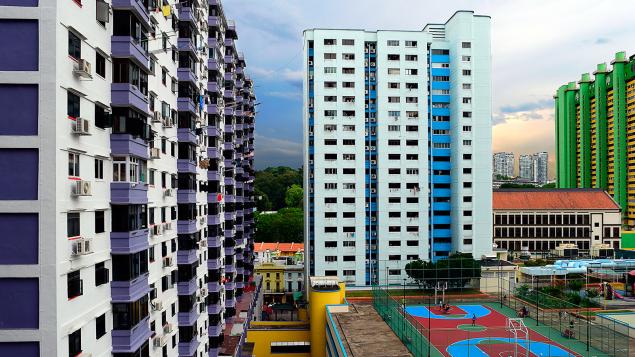
Individual attention, the results of the fight against corruption. Today, the state practically does not leave a place in the top ten countries with the lowest level of it. As a result of many ratings Singapore staked the leading and top positions. So in the Transparency International ranking in 2015 the country ranked the 8th place, and its closest neighbors - Malaysia and Indonesia, respectively, 54th and 88th
. Under the terms of business of Singapore has the 9th consecutive year, led by a prestigious international ranking World Bank. Ookla awarded Singapore the status of the country and the nation with the most high-speed internet, and Tufts University - the most dynamically developing digital economy in the world
. Unique business environment and the promotion of IT-initiatives beneficial impact on the development of the city's entire infrastructure. But if before 2014 they were, rather, the individual, though large-scale projects, the 2014 smart integration technology in Singapore reached the level of the national program.
Smart Nation
An expert in the field of innovative urban development Bill Hutchinson conventionally divides the town in the smart version: 1.0, 2.0 and 3.0. Smart City 1.0 develops without an overall strategy, there are automated individual, unconnected elements. Version 2.0 integrates initiatives, builds relationships and aims to bring together as many sources of information. The smart city for version 3.0 performed a complex mix of strategic and smart technologies are becoming an integral part of the infrastructure. It is this level in its development has reached Singapore today.
About Smart Nation
On the official launch of the Smart Nation national project ( "Intelligent Nation"), Singapore's Prime Minister Lee Hsien Loong announced November 24, 2014. The project provides for joint action of the government, the city's residents and businesses to improve the quality of life of residents and modernization of the economy. Given the high population density of 8 000 people per 1 square. km. (200 times more for the same unit area than in the US, and a thousand times more than in Russia) and its total population of 5.7 million. Man to optimize the overloaded urban infrastructure systems are special requirements.
five main areas highlighted in the part of the program: reducing the effect of overpopulation, solution aging nation, raising the level and quality of care, the creation of sustainable energy and transport networks. For each of the areas of Smart Nation project has its own unique solutions.
Transportation
Total area of Singapore roads, which moves about a million cars occupy 12% of the territory, while the total living - 14% of the area of the city-state. And here crucially important for Singapore becomes lower transport loads. This problem can be solved in several ways.
The town is excellent public transport system. Most of the city's underground (Mass Rapid Transit (MRT)) is completely automated and works in an unmanned mode. Information about the arrival time of the bus and the number of vacant seats in it is always possible to find out, using a special application. Distributed karsheringa system.
Since 2010, Singapore has a contactless payment program in any directions by public transport with the help of maps. The city has a program of priority directions of buses at traffic lights, and at many crossings are installed devices that extend a green signal for the elderly and people with reduced mobility since the social card applications.
Significant reduction in the number of public transport will be achieved through the introduction of public unmanned vehicles. Now the city has already tested these cars developed in the National University of Singapore and the Singapore-MIT Alliance for Research and Technology (SMART). By optimizing the traffic flow will be able to reduce the number of traffic jams, which, according to experts, will provide economic benefit of more than $ 40 million annually.
Electronic Parking Guidance System (PGS) podyschet motorists free parking space, and the system of Electronic Road Pricing (ERP) itself will write off money for it, and work on the ERP in-car devices (In-Vehicle Unit, IU). The same system will relieve the driver from having to take the time to pay for the use of roads and transportation in certain areas of the city. Local IU system is defined by a citywide system of surveillance cameras, and generates the corresponding account. One day "unlimited" drive on the roads of the city will cost five Singapore dollars (about $ 3, 5). Implementing only one of this system allowed to reduce traffic during peak hours by 15% and increase the average speed of movement on the roads of the city by 20%.
In 2015, it was developed by Smart Mobile 2030 urban transport system development plan with a vision for the next 15 years with the introduction of technologies of interaction between the vehicles themselves and with the urban infrastructure.
The cost of personal compact car and a 10-year license - another factor that really affects the loading of the transport infrastructure. High import taxes accelerates subcompact price to $ 50,000, while, depending on the engine capacity and vehicle size, the cost of the license, which is paid regardless of the value of cars is between $ 77 000 to $ 93 000.
Interactive map of Singapore in real-time to provide comprehensive information about what is happening in your area of interest, up to the number of people, traffic or high water level.
Against the background of the neighboring metropolises Singapore looks like an intellectual, unwittingly forced to endure the dubious company. So Phnom Penh (Cambodia) today can not only boast the metro, but also the traffic lights at the crossroads of the individual, the presence of road signs in the right places and a single-wide bus system. The Koala Lumpur (Malaysia), the situation with the land transport looks dramatically in Ho Chi Minh City (Vietnam) flooded the road motorized transport, moving according to its own rules.
Taking care of each and every
According to the World Health Organization, by 2025 10% of the world population will exceed 65 years. In Singapore, this is the age limit will be overcome by 2030, and only every fifth inhabitant. In addition to numerous programs of social and financial support, in the country to help seniors technologies are active. Thus, for example, in the homes of the elderly mounted sensors, analyzing the movement space in a residential home. If the time limit is exceeded without movement, nurse or relatives receive a text message. Now the service is being tested and will be distributed and supported by the citizens in their homes for free.
Another manifestation of concern for the residents of the city - the possibility of remote medical services. Today, in several hospitals in the city are testing diagnostic system, allowing to obtain the required information over wireless networks from sensors attached to the patient's body. The active support of the state will provide an opportunity to integrate telecommunication systems with the doctors in the social housing and the national health system, as well as the possibility to use experts from the various communities to help people to social and emotional support.
Now under development telereabilitatsii program, which will allow to communicate with psychiatrists on Skype. In some cases, these services are essential and can save both sides time.

Singapore and the environment
Almost complete lack of natural resources, including drinking water, it becomes a powerful stimulus for the development of clean technologies, renewable energy makes environmental issues, renewable energy. And this country has to demonstrate that: the results of research in 2011 conducted a division of Siemens Green Cities city has received the highest rating for the development of environmental technologies among the Asian cities.
Colossal "trees" in the garden city - this is not only a famous tourist attraction. They effectively absorb heat and accumulate rainwater, and on top of each of the 18 facilities were placed solar panels that collect energy for garden lighting.
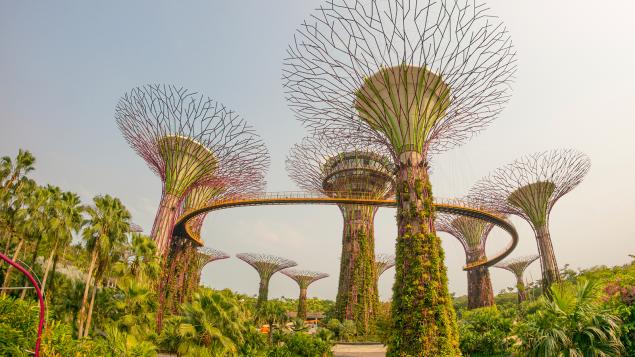
The sanitary condition of the city streets with the help of advanced video analytics systems and smart waste containers, developed by experts of the Singapore Temasek Polytechnic Institute and ZWEEC Analytics is controlled automatically.
Water scarcity has stimulated the establishment of Singapore's progressive water management systems, including systems for rainwater collection, treatment and reuse of wastewater. Developed and new, more efficient technologies doubled desalination of salt water. Efforts in these areas cost the city budget, the country is not cheap, but the dividends are worth their Singapore today has expertise services in water management in the Asian region
plans for the next. " 15 tiletku »
Not stopping there, it's in their own unique mini-state continues to build and implement its ambitious plans. Among them are already approved by the government's development program level until 2030, which implies, in particular: utilization of up to 70% of its waste, an improvement of 35% compared with 2005, energy consumption indicators, certification, 80% of buildings rated green building BCA Green Mark , increasing the share of public transport in the transport system of the structure of the country to 75%. These trends - this is only a small part of the sustainable development of Singapore for the foreseeable future. Details of the approved plans and prospects of development of the city is updated on the site.
Becoming a unique proving ground for the running of the newest technologies, today Singapore has learned to successfully export cutting-edge ideas. One of these areas to adapt their own inventions became the city of Tianjin in China. In free from the effects of severe chemical pollution in the former industrial area where today is built eco-city, which plays the role of a pilot project, an example for the future of the Chinese settlements, where the level of pollution has reached critical. Singapore, with China acted as an investor by dividing an investment portfolio at a ratio of 50/50. The city should be "delivered" to the mid-2020s and will create favorable conditions for the life of 350 thousand inhabitants.
One of Singapore's development at the intersection of high-tech - smart wallpaper with implanted in them throughout the area microphones, sensors and speakers.

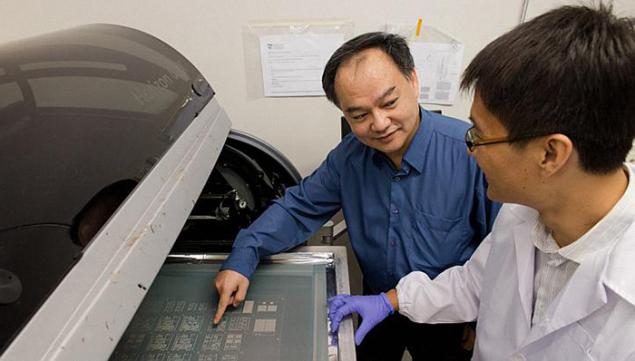
Outwardly invisible, they are controlled by a computer located in the next room or in specially designated for this purpose of the building. So the wall becomes part of a single ecosystem of living space, creating not only a special level of comfort and convenience, but also quite tangible practical value.
Based on the information collected centrally in the city already launched more than 100 initiatives. On public services portal available ecitizen approximately 650 different online services. Correspondence with various municipal services can be synchronized in a single mailbox through Oneinbox platform. All data, comfortably structured along the lines can always be found on the information portal of the city.
Singapore's Got Talent
Staying true to its strategic priorities, the Singapore government actively supports the initiative and is investing heavily in the research of talented developers on the basis of the two laboratories of leading universities of the country - National University of Singapore and Nanyang Technological University. The total investment in this area over the past 25 years amounted to nearly $ 22 billion. This allowed many projects to bring promising young engineers and researchers at the commercial level. Only in 2011 these investments have given life to 400 start-ups and allow registered 800 patents. This year, the government has invested in a new five-year plan for research support in the amount of $ 13, 8 billion.
In March 2016 Info-communications Development Authority of Singapore launched the program «Smart Nation Fellowship», aimed at attracting Singapore's intellectual potential - researchers, developers and engineers from around the world for a period of three months. So the government is creating new opportunities for accumulation and the creation of technology, eleotuj, who will be able to improve people's living standards and quality to develop the city's infrastructure. Try your luck to professionals in the field of IT - technology is always possible on the project site, which is subject to the respective application
.
Singapore - a paradise for start-ups
A special "weakness" of the government and the community initiative of Singapore has for start-ups. The country has positioned itself as a global laboratory for testing new ideas and technologies. Creating better conditions for development, Singapore is actively engaging IT-business. Как нельзя кстати здесь оказывается его удачное расположение в центре Юго-Восточной Азии — в радиусе пяти-шести часов лета проживает более 4, 2 млрд человек. Почти 95% территории города охвачено сетью высокоскоростного интернета (1 Гб/с). И это приносит свои результаты: сегодня 40% всех стартапов Юго-Восточной Азии обосновались именно в Сингапуре.

Стартап-среда в Сингапуре
В 2011 году в промышленной зоне Ayer Rajah Industrial Estate здание «Блок 71» (Blk71) вместо запланированного сноса было подвержено масштабной реконструкции и превратилось в уникальный технологический хаб, «приютивший» 250 стартапов, инвесторов и бизнес-инкубаторов. По оценкам The Economist здесь была создана «самая плотная и эффективная бизнес-экосистема в мире». В 2015 году к «Блоку 71» добавились еще два — «Блок 73» и «Блок 79», получивших название BASH (Build Amazing Startups Here), что создало возможности для увеличения числа привлеченных стартапов вдвое.
Приватность «по-сингапурски»
В соответствии с законодательством Сингапура, любое решение, связанное с использованием собранных Smart Nation данных не требует дальнейшего согласования в суде или с мнением граждан. Здесь в массе все согласились с тем, что государство лучше понимает, какой информацией и в какой мере оно может и должно владеть. Так, к примеру, с 2011 года абсолютно все дороги и переулки в Сингапуре пребывают под неусыпным видеонаблюдением. Это позволяет, с одной стороны, исключить безнаказанное нарушение ПДД, с другой, — обеспечить беспрецедентно высокий уровень контроля всей городской экосистемы. И именно здесь, в Сингапуре, человек, бросивший окурок из окна многоэтажки поплатился за это штрафом в $14 000.
В Сингапуре принята однопартийная политическая система и достаточно остро ощущаются ограничения свободы слова. Во Всемирном рейтинге свободы прессы 2016 года Сингапур расположился на 154-е месте. И это также вынужденная плата жителей страны за рост благосостояния и заботу государства. Для человека, впервые попавшего в Сингапур, вездесущее «второе око напротив» вызывает двойственное чувство, но абсолютное большинство жителей города уже давно сделали свой выбор: некоторыми свободами вполне можно пожертвовать, если конечная цель таких ограничений — рост благосостояния населения и технологического развития городской инфраструктуры. И особую роль здесь сыграл высокий рейтинг доверия правительству, делом доказавшему верность своим приоритетам и обещаниям.
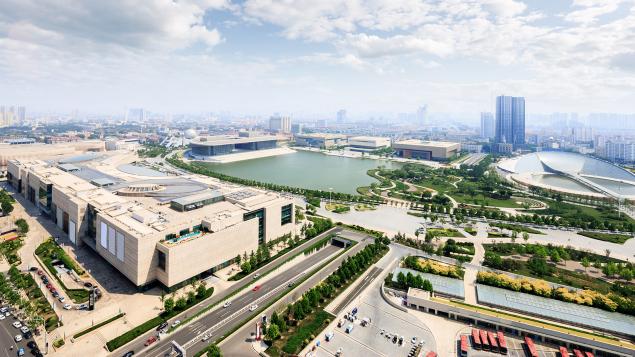
T&P
На этом всё, с вами был Dronk.Ru. Не забывайте возвращать деньги за покупки в Китае и подписываться на наш блог, будет ещё много интересного.

Рекомендуем:
— Экономим до 8% с каждой покупки на AliExpress и других интернет-магазинах Китая
- Why do online shops give the money for the purchase
? - Return the money - Choosing a cashback service to Aliexpress
— История развития Dronk.ru — от выбора квадрокоптеров до возвращения денег за покупки на AliExpress и не только
— Лучший кэшбэк сервис или 5 основных критериев оценки кэшбэк-сервиса
Источник: geektimes.ru/company/dronk/blog/277972/

Smart Nation project, supported by the Government of Singapore, managed to unite entrepreneurs, scientists, officials and citizens in the framework of common objectives for the implementation of new technologies in everyday life and the creation of a pragmatic and comfortable environment. The ambitious plans of Singapore - claim to being the most technologically advanced country in the world. "To survive, the Singapore government has to be extraordinary. If we are ordinary, we simply will not "- so once defined his view of the future of this wonderful country one of the national leaders of the XX century and the authors of" Singapore economic miracle "Lee Kuan Yew
After separation from Malaysia in the mid 60-ies of the XX century, Singapore was in a very dependent and straitened circumstances - without an army and support between the permanent conflict Indonesia and Malaysia, one-on-one with social and economic problems, with extremely limited access to natural resources and, of course, traditional Asian level corruption. From the standpoint of the history of mankind timeslot looks negligible, but these few decades have become a real challenge for the country in 50 years, she was able to pass with dignity.

The planned development of the market economy, international investment flows, relentless fight against corruption and skilful diplomacy in the international arena brought to Singapore for the first position on the level of well-being on a global scale. The rapid economic growth in the period from the 60s to the 90s of XX century identified for Singapore, as well as to Hong Kong, Taiwan and South Korea in the famous "four Asian tigers." The decisive role played in this achievement rate for the electronics development and implementation of cutting-edge technologies. This, in turn, allowed the beginning of the third millennium, to create the country's excellent conditions for further rapid development of information technology.
Some statistics
For success in the implementation of the program of mass introduction of high-speed Internet, which is a city-state launched in 1998, the year in 1999. The Intelligent Community Forum (ICF) has recognized Singapore best "Intelligent Community of the Year". The spread of the Internet at this stage are actively supported by the government, which allowed already by 2003 to connect to the network 65% of homes and workplaces. At the same time 74% of the population of Singapore owned PC.
At the beginning of the 3rd millennium Singapore focused on IT-technologies, shifting the emphasis on creating the most comfortable conditions for the development of innovative businesses, both through attracting international intellectual resources, as well as through the support of its own entrepreneurs and innovators. The slogan: "Join us in the online mode for 15 minutes," perfectly illustrates the main priorities of Singapore at the time, reflected at the level of large-scale state support of innovation business. From 2005 to 2014 the number of promising start-ups in the country increased from 24 thousand to 55 thousand. In 2013, Singapore's technological business initiatives raised $ 1, 7 billion investment, ahead of leading Asian competitors - Japan, South Korea and Hong Kong
.

Individual attention, the results of the fight against corruption. Today, the state practically does not leave a place in the top ten countries with the lowest level of it. As a result of many ratings Singapore staked the leading and top positions. So in the Transparency International ranking in 2015 the country ranked the 8th place, and its closest neighbors - Malaysia and Indonesia, respectively, 54th and 88th
. Under the terms of business of Singapore has the 9th consecutive year, led by a prestigious international ranking World Bank. Ookla awarded Singapore the status of the country and the nation with the most high-speed internet, and Tufts University - the most dynamically developing digital economy in the world
. Unique business environment and the promotion of IT-initiatives beneficial impact on the development of the city's entire infrastructure. But if before 2014 they were, rather, the individual, though large-scale projects, the 2014 smart integration technology in Singapore reached the level of the national program.
Smart Nation
An expert in the field of innovative urban development Bill Hutchinson conventionally divides the town in the smart version: 1.0, 2.0 and 3.0. Smart City 1.0 develops without an overall strategy, there are automated individual, unconnected elements. Version 2.0 integrates initiatives, builds relationships and aims to bring together as many sources of information. The smart city for version 3.0 performed a complex mix of strategic and smart technologies are becoming an integral part of the infrastructure. It is this level in its development has reached Singapore today.
About Smart Nation
On the official launch of the Smart Nation national project ( "Intelligent Nation"), Singapore's Prime Minister Lee Hsien Loong announced November 24, 2014. The project provides for joint action of the government, the city's residents and businesses to improve the quality of life of residents and modernization of the economy. Given the high population density of 8 000 people per 1 square. km. (200 times more for the same unit area than in the US, and a thousand times more than in Russia) and its total population of 5.7 million. Man to optimize the overloaded urban infrastructure systems are special requirements.
five main areas highlighted in the part of the program: reducing the effect of overpopulation, solution aging nation, raising the level and quality of care, the creation of sustainable energy and transport networks. For each of the areas of Smart Nation project has its own unique solutions.
Transportation
Total area of Singapore roads, which moves about a million cars occupy 12% of the territory, while the total living - 14% of the area of the city-state. And here crucially important for Singapore becomes lower transport loads. This problem can be solved in several ways.
The town is excellent public transport system. Most of the city's underground (Mass Rapid Transit (MRT)) is completely automated and works in an unmanned mode. Information about the arrival time of the bus and the number of vacant seats in it is always possible to find out, using a special application. Distributed karsheringa system.
Since 2010, Singapore has a contactless payment program in any directions by public transport with the help of maps. The city has a program of priority directions of buses at traffic lights, and at many crossings are installed devices that extend a green signal for the elderly and people with reduced mobility since the social card applications.
Significant reduction in the number of public transport will be achieved through the introduction of public unmanned vehicles. Now the city has already tested these cars developed in the National University of Singapore and the Singapore-MIT Alliance for Research and Technology (SMART). By optimizing the traffic flow will be able to reduce the number of traffic jams, which, according to experts, will provide economic benefit of more than $ 40 million annually.
Electronic Parking Guidance System (PGS) podyschet motorists free parking space, and the system of Electronic Road Pricing (ERP) itself will write off money for it, and work on the ERP in-car devices (In-Vehicle Unit, IU). The same system will relieve the driver from having to take the time to pay for the use of roads and transportation in certain areas of the city. Local IU system is defined by a citywide system of surveillance cameras, and generates the corresponding account. One day "unlimited" drive on the roads of the city will cost five Singapore dollars (about $ 3, 5). Implementing only one of this system allowed to reduce traffic during peak hours by 15% and increase the average speed of movement on the roads of the city by 20%.
In 2015, it was developed by Smart Mobile 2030 urban transport system development plan with a vision for the next 15 years with the introduction of technologies of interaction between the vehicles themselves and with the urban infrastructure.
The cost of personal compact car and a 10-year license - another factor that really affects the loading of the transport infrastructure. High import taxes accelerates subcompact price to $ 50,000, while, depending on the engine capacity and vehicle size, the cost of the license, which is paid regardless of the value of cars is between $ 77 000 to $ 93 000.
Interactive map of Singapore in real-time to provide comprehensive information about what is happening in your area of interest, up to the number of people, traffic or high water level.
Against the background of the neighboring metropolises Singapore looks like an intellectual, unwittingly forced to endure the dubious company. So Phnom Penh (Cambodia) today can not only boast the metro, but also the traffic lights at the crossroads of the individual, the presence of road signs in the right places and a single-wide bus system. The Koala Lumpur (Malaysia), the situation with the land transport looks dramatically in Ho Chi Minh City (Vietnam) flooded the road motorized transport, moving according to its own rules.
Taking care of each and every
According to the World Health Organization, by 2025 10% of the world population will exceed 65 years. In Singapore, this is the age limit will be overcome by 2030, and only every fifth inhabitant. In addition to numerous programs of social and financial support, in the country to help seniors technologies are active. Thus, for example, in the homes of the elderly mounted sensors, analyzing the movement space in a residential home. If the time limit is exceeded without movement, nurse or relatives receive a text message. Now the service is being tested and will be distributed and supported by the citizens in their homes for free.
Another manifestation of concern for the residents of the city - the possibility of remote medical services. Today, in several hospitals in the city are testing diagnostic system, allowing to obtain the required information over wireless networks from sensors attached to the patient's body. The active support of the state will provide an opportunity to integrate telecommunication systems with the doctors in the social housing and the national health system, as well as the possibility to use experts from the various communities to help people to social and emotional support.
Now under development telereabilitatsii program, which will allow to communicate with psychiatrists on Skype. In some cases, these services are essential and can save both sides time.

Singapore and the environment
Almost complete lack of natural resources, including drinking water, it becomes a powerful stimulus for the development of clean technologies, renewable energy makes environmental issues, renewable energy. And this country has to demonstrate that: the results of research in 2011 conducted a division of Siemens Green Cities city has received the highest rating for the development of environmental technologies among the Asian cities.
Colossal "trees" in the garden city - this is not only a famous tourist attraction. They effectively absorb heat and accumulate rainwater, and on top of each of the 18 facilities were placed solar panels that collect energy for garden lighting.

The sanitary condition of the city streets with the help of advanced video analytics systems and smart waste containers, developed by experts of the Singapore Temasek Polytechnic Institute and ZWEEC Analytics is controlled automatically.
Water scarcity has stimulated the establishment of Singapore's progressive water management systems, including systems for rainwater collection, treatment and reuse of wastewater. Developed and new, more efficient technologies doubled desalination of salt water. Efforts in these areas cost the city budget, the country is not cheap, but the dividends are worth their Singapore today has expertise services in water management in the Asian region
plans for the next. " 15 tiletku »
Not stopping there, it's in their own unique mini-state continues to build and implement its ambitious plans. Among them are already approved by the government's development program level until 2030, which implies, in particular: utilization of up to 70% of its waste, an improvement of 35% compared with 2005, energy consumption indicators, certification, 80% of buildings rated green building BCA Green Mark , increasing the share of public transport in the transport system of the structure of the country to 75%. These trends - this is only a small part of the sustainable development of Singapore for the foreseeable future. Details of the approved plans and prospects of development of the city is updated on the site.
Becoming a unique proving ground for the running of the newest technologies, today Singapore has learned to successfully export cutting-edge ideas. One of these areas to adapt their own inventions became the city of Tianjin in China. In free from the effects of severe chemical pollution in the former industrial area where today is built eco-city, which plays the role of a pilot project, an example for the future of the Chinese settlements, where the level of pollution has reached critical. Singapore, with China acted as an investor by dividing an investment portfolio at a ratio of 50/50. The city should be "delivered" to the mid-2020s and will create favorable conditions for the life of 350 thousand inhabitants.
One of Singapore's development at the intersection of high-tech - smart wallpaper with implanted in them throughout the area microphones, sensors and speakers.


Outwardly invisible, they are controlled by a computer located in the next room or in specially designated for this purpose of the building. So the wall becomes part of a single ecosystem of living space, creating not only a special level of comfort and convenience, but also quite tangible practical value.
Based on the information collected centrally in the city already launched more than 100 initiatives. On public services portal available ecitizen approximately 650 different online services. Correspondence with various municipal services can be synchronized in a single mailbox through Oneinbox platform. All data, comfortably structured along the lines can always be found on the information portal of the city.
Singapore's Got Talent
Staying true to its strategic priorities, the Singapore government actively supports the initiative and is investing heavily in the research of talented developers on the basis of the two laboratories of leading universities of the country - National University of Singapore and Nanyang Technological University. The total investment in this area over the past 25 years amounted to nearly $ 22 billion. This allowed many projects to bring promising young engineers and researchers at the commercial level. Only in 2011 these investments have given life to 400 start-ups and allow registered 800 patents. This year, the government has invested in a new five-year plan for research support in the amount of $ 13, 8 billion.
In March 2016 Info-communications Development Authority of Singapore launched the program «Smart Nation Fellowship», aimed at attracting Singapore's intellectual potential - researchers, developers and engineers from around the world for a period of three months. So the government is creating new opportunities for accumulation and the creation of technology, eleotuj, who will be able to improve people's living standards and quality to develop the city's infrastructure. Try your luck to professionals in the field of IT - technology is always possible on the project site, which is subject to the respective application
.

Singapore - a paradise for start-ups
A special "weakness" of the government and the community initiative of Singapore has for start-ups. The country has positioned itself as a global laboratory for testing new ideas and technologies. Creating better conditions for development, Singapore is actively engaging IT-business. Как нельзя кстати здесь оказывается его удачное расположение в центре Юго-Восточной Азии — в радиусе пяти-шести часов лета проживает более 4, 2 млрд человек. Почти 95% территории города охвачено сетью высокоскоростного интернета (1 Гб/с). И это приносит свои результаты: сегодня 40% всех стартапов Юго-Восточной Азии обосновались именно в Сингапуре.

Стартап-среда в Сингапуре
В 2011 году в промышленной зоне Ayer Rajah Industrial Estate здание «Блок 71» (Blk71) вместо запланированного сноса было подвержено масштабной реконструкции и превратилось в уникальный технологический хаб, «приютивший» 250 стартапов, инвесторов и бизнес-инкубаторов. По оценкам The Economist здесь была создана «самая плотная и эффективная бизнес-экосистема в мире». В 2015 году к «Блоку 71» добавились еще два — «Блок 73» и «Блок 79», получивших название BASH (Build Amazing Startups Here), что создало возможности для увеличения числа привлеченных стартапов вдвое.
Приватность «по-сингапурски»
В соответствии с законодательством Сингапура, любое решение, связанное с использованием собранных Smart Nation данных не требует дальнейшего согласования в суде или с мнением граждан. Здесь в массе все согласились с тем, что государство лучше понимает, какой информацией и в какой мере оно может и должно владеть. Так, к примеру, с 2011 года абсолютно все дороги и переулки в Сингапуре пребывают под неусыпным видеонаблюдением. Это позволяет, с одной стороны, исключить безнаказанное нарушение ПДД, с другой, — обеспечить беспрецедентно высокий уровень контроля всей городской экосистемы. И именно здесь, в Сингапуре, человек, бросивший окурок из окна многоэтажки поплатился за это штрафом в $14 000.
В Сингапуре принята однопартийная политическая система и достаточно остро ощущаются ограничения свободы слова. Во Всемирном рейтинге свободы прессы 2016 года Сингапур расположился на 154-е месте. И это также вынужденная плата жителей страны за рост благосостояния и заботу государства. Для человека, впервые попавшего в Сингапур, вездесущее «второе око напротив» вызывает двойственное чувство, но абсолютное большинство жителей города уже давно сделали свой выбор: некоторыми свободами вполне можно пожертвовать, если конечная цель таких ограничений — рост благосостояния населения и технологического развития городской инфраструктуры. И особую роль здесь сыграл высокий рейтинг доверия правительству, делом доказавшему верность своим приоритетам и обещаниям.

T&P
На этом всё, с вами был Dronk.Ru. Не забывайте возвращать деньги за покупки в Китае и подписываться на наш блог, будет ещё много интересного.

Рекомендуем:
— Экономим до 8% с каждой покупки на AliExpress и других интернет-магазинах Китая
- Why do online shops give the money for the purchase
? - Return the money - Choosing a cashback service to Aliexpress
— История развития Dronk.ru — от выбора квадрокоптеров до возвращения денег за покупки на AliExpress и не только
— Лучший кэшбэк сервис или 5 основных критериев оценки кэшбэк-сервиса
Источник: geektimes.ru/company/dronk/blog/277972/
"Terminator 2: Judgment Day" celebrates 25th anniversary
Abandoned monuments to the socialist era, Yugoslavia.

